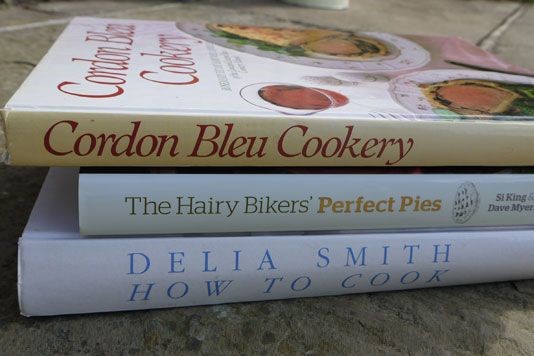The expert's guide to pastry - Cordon Bleu Cookery

In her final piece looking at the best chefs and their books, Laura Rowe gets to grips with perfect pastry.
The wild card: Rosemary Hume and Muriel Downes' Cordon Bleu Cookery
Raid through your parents or grandparents kitchen cupboards, and if you are lucky enough, you’ll stumble across a classic like this. Fun fact: Rosemary Hume was the lady behind the great British classic, Coronation chicken!
 As well as containing a pleasingly retro and ever-so-slightly musty ‘Body Sculpture’ poster as a bookmark (thanks mum), my 1984 Treasure Press edition of Cordon Bleu Cookery has a large section on pastry. Rosemary and Muriel tell us that pastry is easy as long as you stick to the rules. You should work in a “cool, airy room” and plan your cooking schedule accordingly. You should use “fresh, fine-sifted plain flour”, “firm but not hard fat” and “ice-cold water”. The fat and flour should be handled “lightly but firmly” as “over-rubbing makes the pastry greasy”. Add the correct amount of water, because too little and it will crumble and be dry; too much and it will shrink, lose shape and produce a tough, hard pastry. Rosemary and Muriel also suggest having a special board, such as a marble slab, slate shelf or laminated plastic surface, for rolling out pastry. They say all pastry must be chilled for about 30 minutes to allow it to “relax”, and the oven must always be preheated to keep the pastry in its correct shape.
As well as containing a pleasingly retro and ever-so-slightly musty ‘Body Sculpture’ poster as a bookmark (thanks mum), my 1984 Treasure Press edition of Cordon Bleu Cookery has a large section on pastry. Rosemary and Muriel tell us that pastry is easy as long as you stick to the rules. You should work in a “cool, airy room” and plan your cooking schedule accordingly. You should use “fresh, fine-sifted plain flour”, “firm but not hard fat” and “ice-cold water”. The fat and flour should be handled “lightly but firmly” as “over-rubbing makes the pastry greasy”. Add the correct amount of water, because too little and it will crumble and be dry; too much and it will shrink, lose shape and produce a tough, hard pastry. Rosemary and Muriel also suggest having a special board, such as a marble slab, slate shelf or laminated plastic surface, for rolling out pastry. They say all pastry must be chilled for about 30 minutes to allow it to “relax”, and the oven must always be preheated to keep the pastry in its correct shape.
Each type of pastry is then given its own introduction, outlining the basic principles (for example shortcrust should have half the amount of fat to flour), several recipes using the pastry, and a picture of the finished dishes. There are also, surprisingly, a few technique images such as pictures detailing how to line a flan dish, one showing how to raise a pork pie case using a glass jar, another on how to roll puff pastry and one to scoop out a giant vol-au-vent. Well, it is the 80s...
The book explains why each pastry is suitable for its specific purpose, which actually makes everything make a lot more sense. There are great tips too, such as using a ball of pastry, rather than your hot fingers, to press pastry into its tin. There are recipes for two types of shortcrust, flaky, two types of rough puff, and puff, American pie pastry, a hot water crust, and sweet and savoury choux.
There are a few questionable bits of advice such as a recommendation to use the cheapest varieties of butter and (firm) margarine for puff pastry, but on the whole this book covers everything you need to know about the basics of most pastries. Just get out your converter as this classic is firmly imperial.
Conclusion:
So, who is the best teacher? Well, that depends on your ambition. Stick with Delia if you are quite happy to keep it simple. If you want to learn lots, and be guided with imagery, then Si and Dave are the bikers to bow to. But if you want a comprehensive lesson, with no frills or fuss, then Cordon Bleu Cookery has it all in there. Other new and very good books, all about pastry, worth looking out for are Richard Bertinet’s Pastry and Eric Lanlard’s Tart it Up.
So, who do you turn to for help with tricky techniques? Do you look for the latest celebrity chef or revert back to the masters?
Previous: The Hairy Bikers’ Perfect Pies
Previous experts series:
The expert's guide to Victoria sponge
The expert's guide to bread making
Comments
Do you want to comment on this article? You need to be signed in for this feature